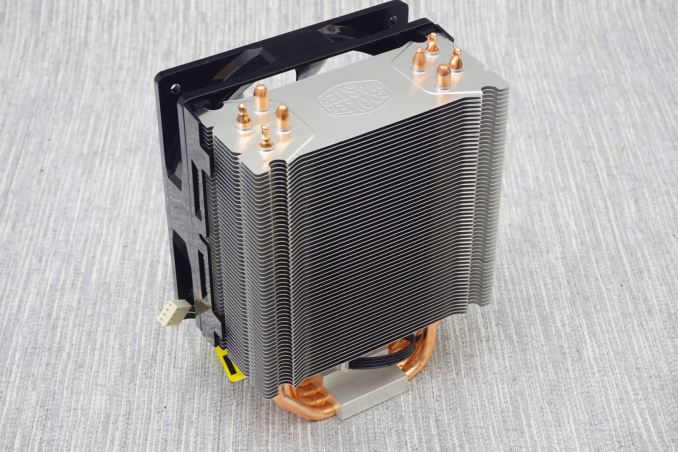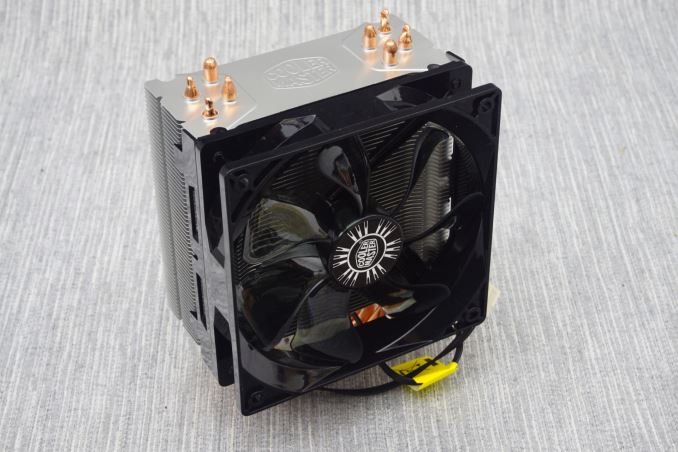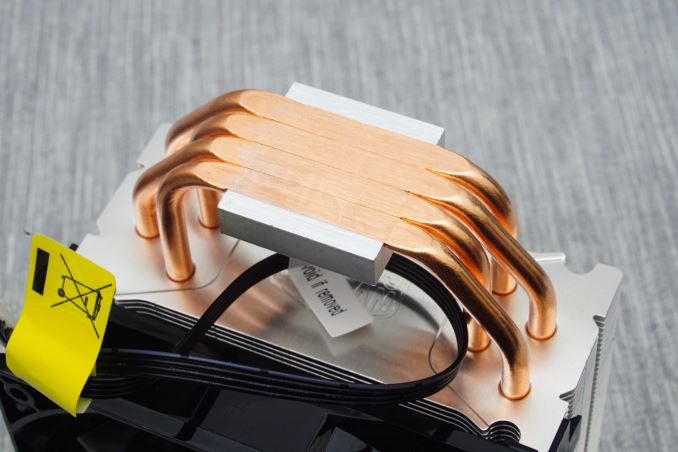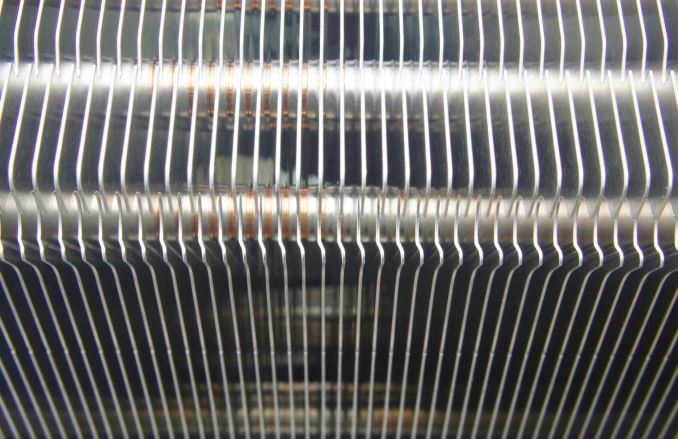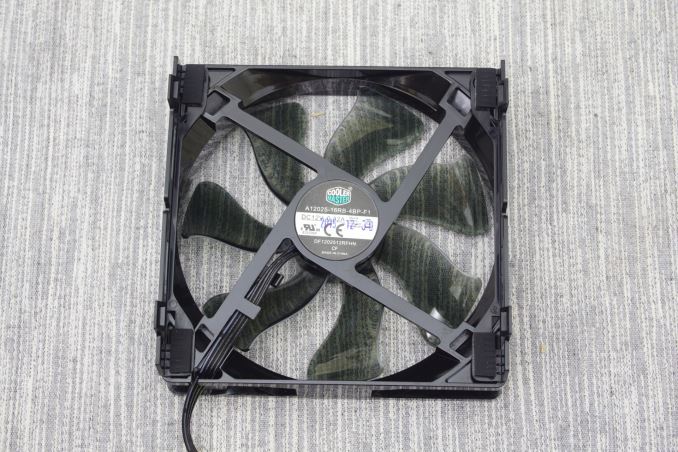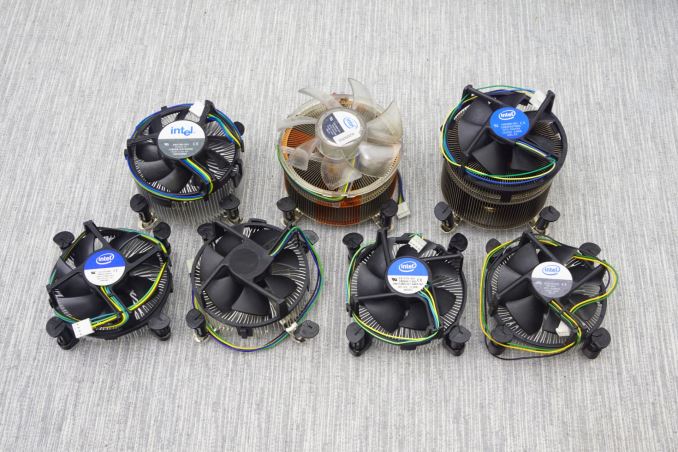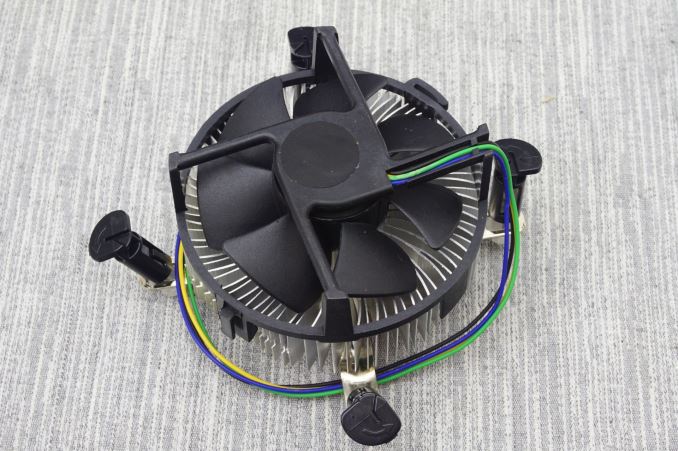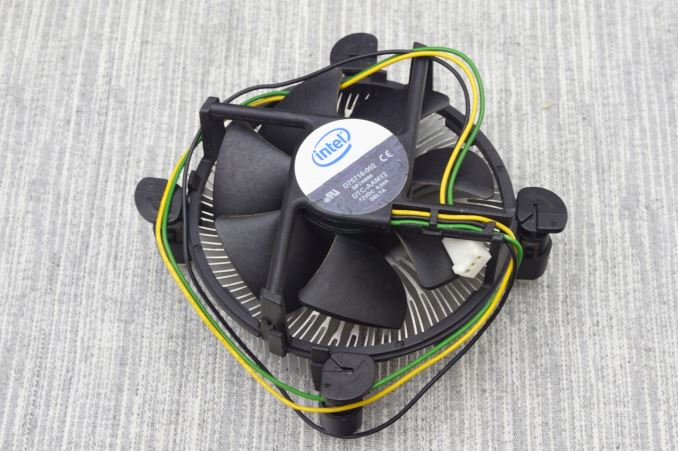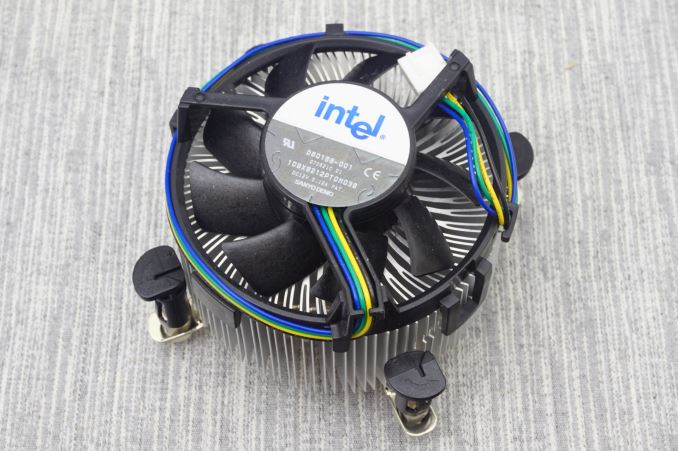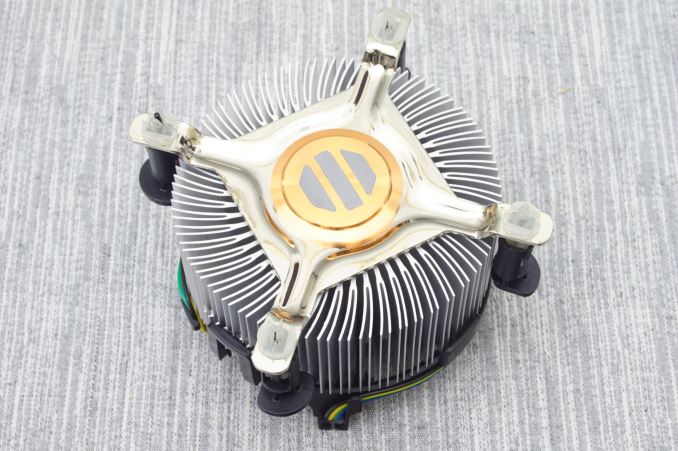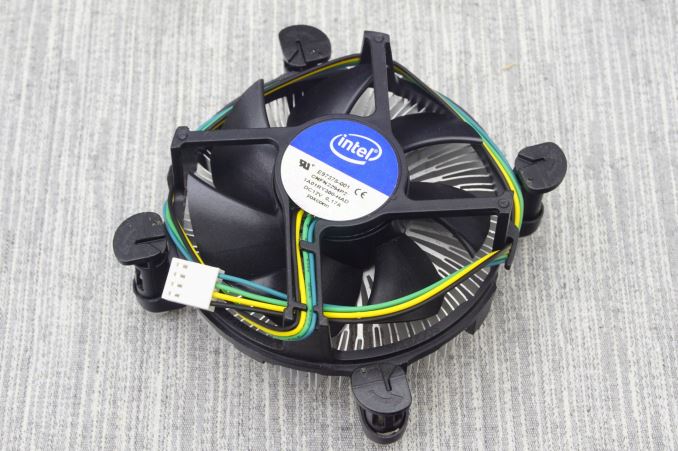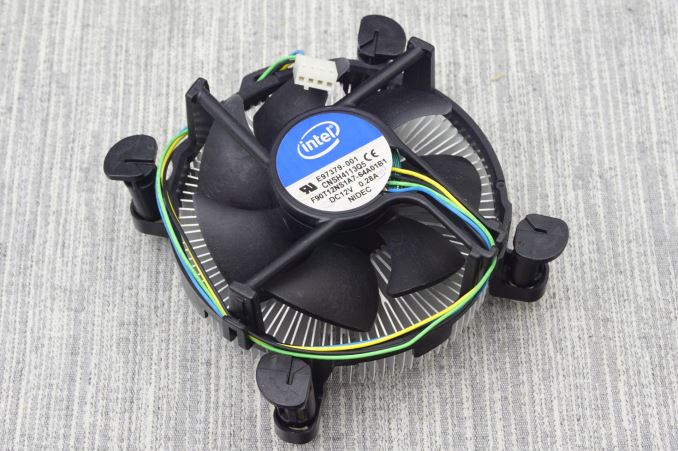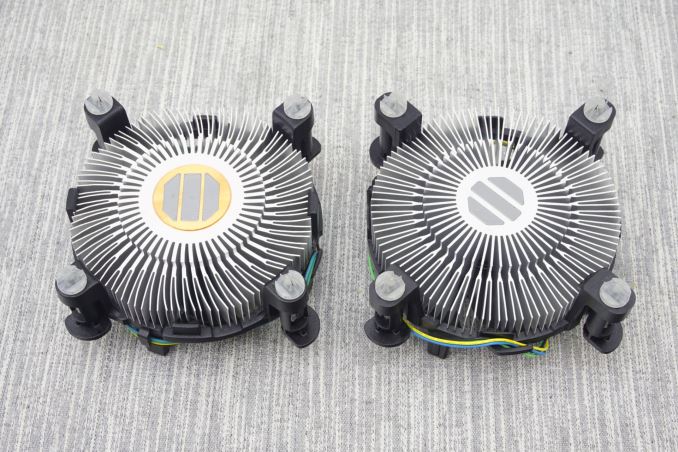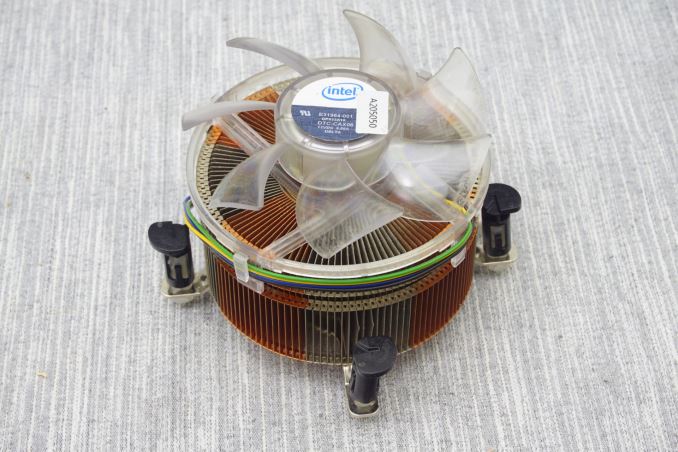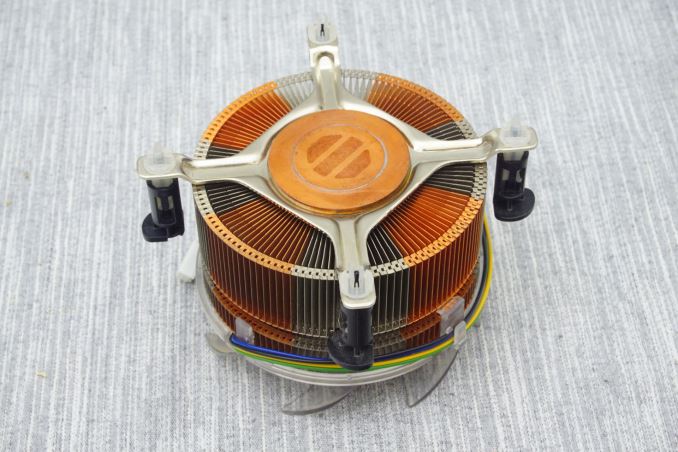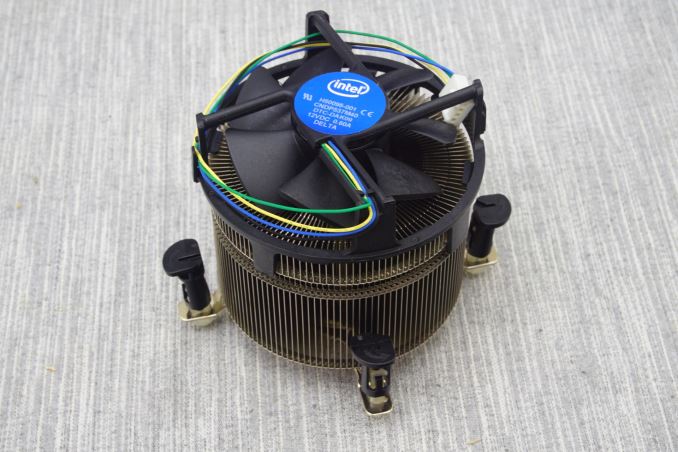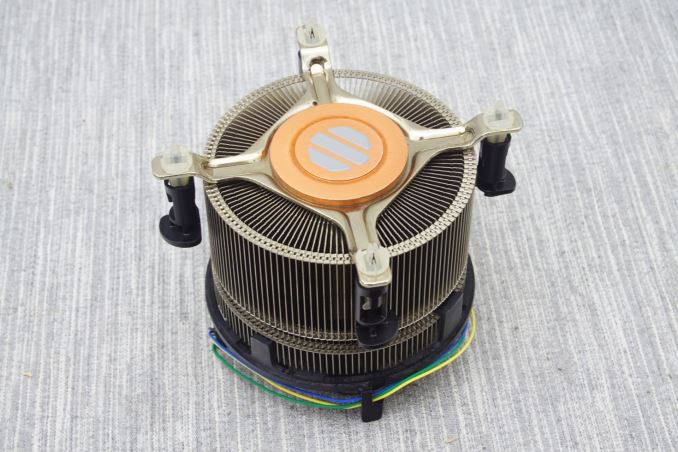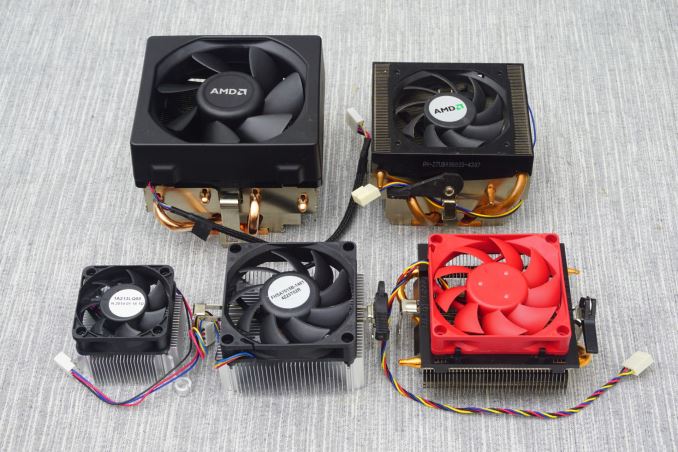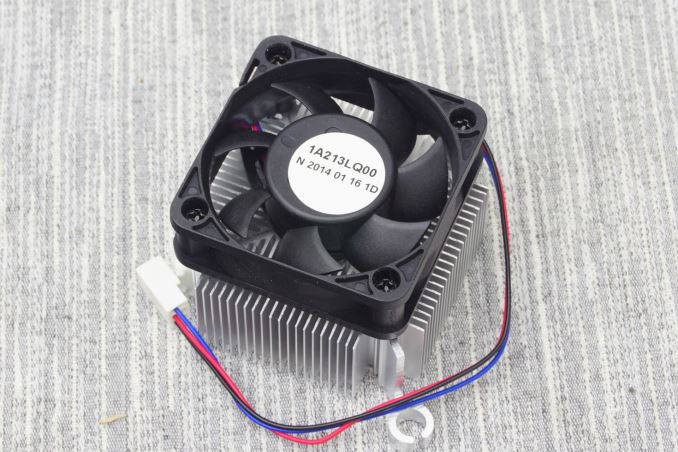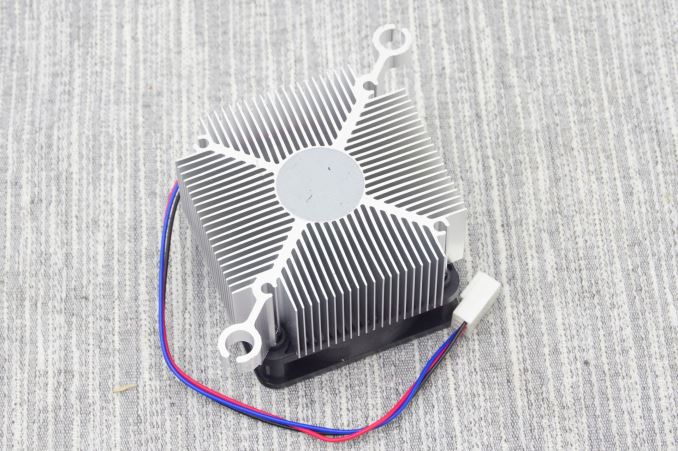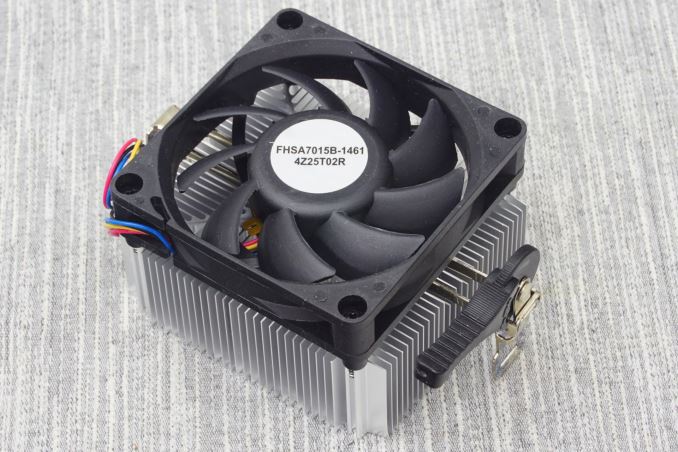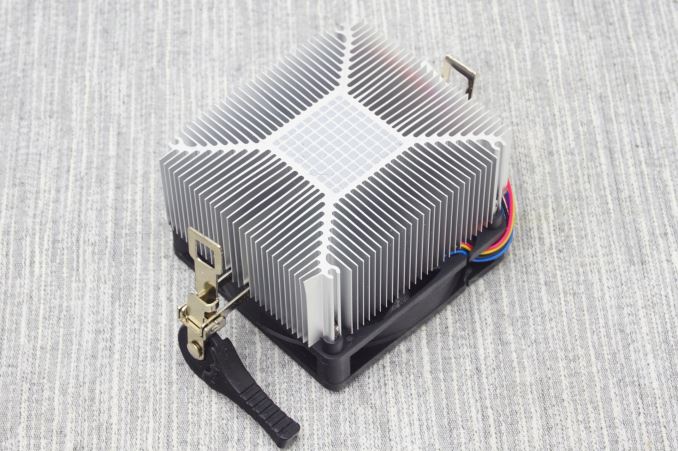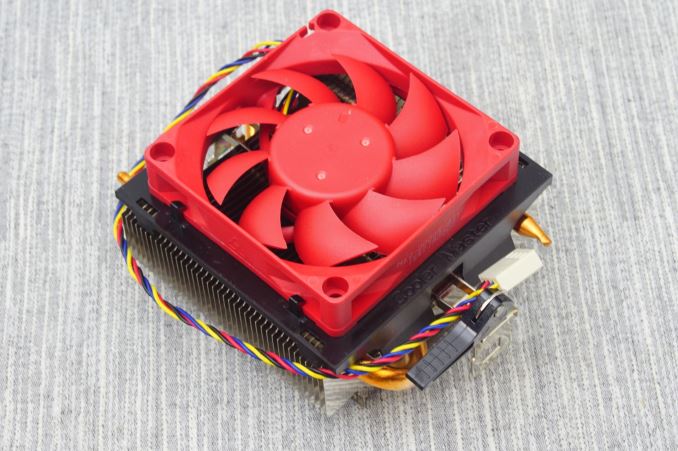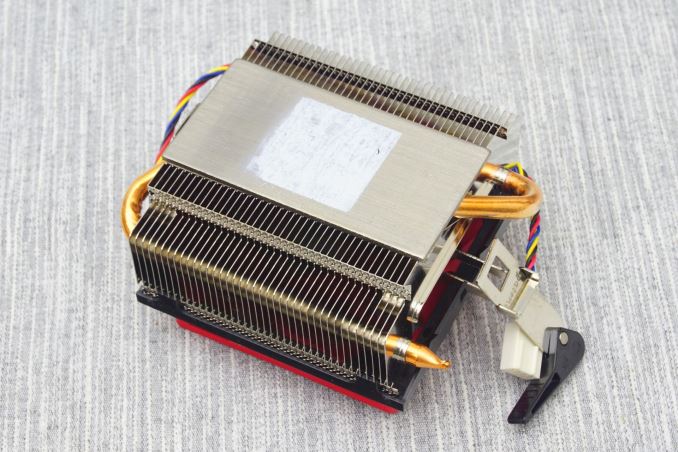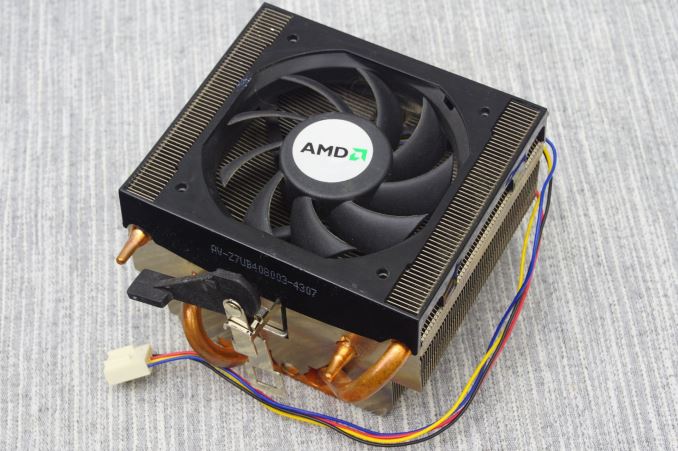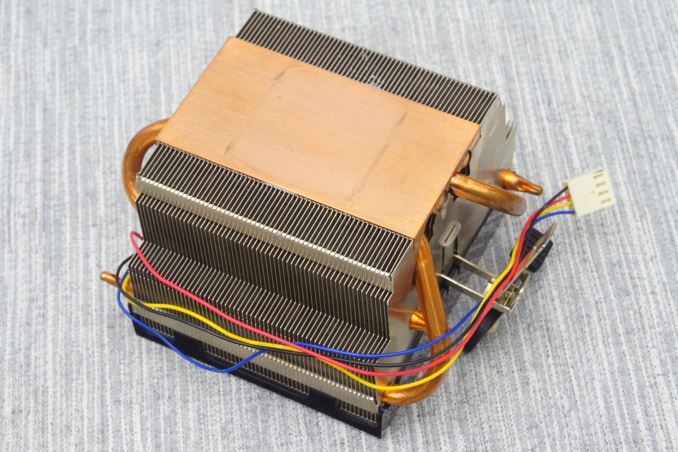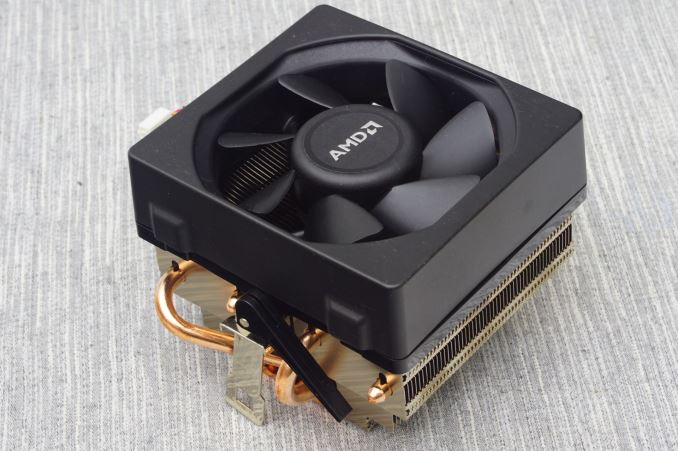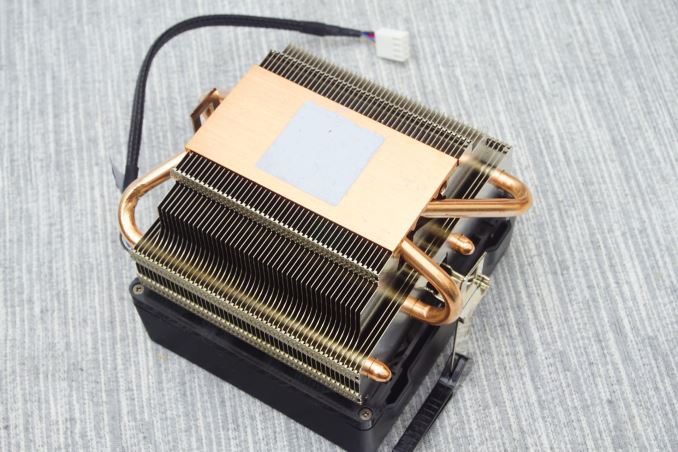
Original Link: https://www.anandtech.com/show/10500/stock-cooler-roundup-intel-amd-vs-evo-212
Battle of The CPU Stock Coolers! 7x Intel vs 5x AMD, plus an EVO 212
by E. Fylladitakis on July 22, 2016 9:00 AM EST- Posted in
- CPUs
- AMD
- Intel
- Cases/Cooling/PSUs
- Cooler Master
- Cooler
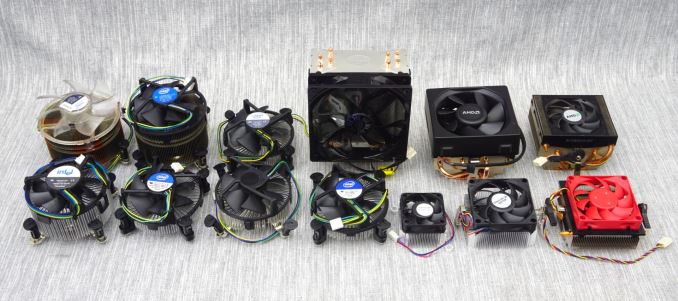
Advanced PC users that like to care for their system commonly believe stock cooling solutions that are supplied with processors to be either barely adequate or too noisy even for a standard, unmodified system operating at stock frequencies. With bulk PC orders it is, of course, a difference scenario when every penny counts. But as a result of the perception of poor cooling from these 'default' coolers, most enthusiast users seek aftermarket cooling solutions. This has created a vast and multivariate demand, and there are so many companies offering such a wide variety of cooling products, from $20 all the way up to custom water cooling solutions. But is that really necessary for a mid-range build? We gathered together around a dozen stock coolers from across the years, from AMD and Intel, and pitted them against the highly rated EVO 212 from Cooler Master.
Introduction
Modern CPUs have become more efficient over time, and have begun to have lower cooling requirements. As a result, the CPU manufacturers have designed some rather advanced stock coolers and are either supplying them alongside their top-tier CPUs or selling them as aftermarket solutions. Despite the fact that these are the 'certified' coolers for the processors, the CPU manufacturer has to make millions, to every hundredth of a cent in manufacturing can be important to the bottom line. It is not easy for the average user to assess just how good the stock cooler really is and how much of an improvement, if any at all, there will be from the purchase of an aftermarket cooler. End users need to be aware of the performance of their current cooling solutions in order to reasonably assess the upgrade that will fit their needs.
In this review we will showcase the thermal performance of some popular stock CPU coolers of the last few years, including the controversial aftermarket Intel BXTS15A and the highly touted AMD Wraith. We also included one of the most popular mainstream coolers available, the Cooler Master EVO 212, as a baseline comparison against aftermarket solutions.
The coolers that we will be testing are in the following table, along with core/fin material listed, the size of the fan, and the overall mass of the cooler as measured on our units. Where heatpipes are in play, these are added into the Core section.
| Vendor | Cooler | Common Bundle | Core | Fins | Fan (mm) |
Mass (g) |
| Intel | D75716-002 | Socket 775 Celerons | Alu | Alu | 80 | 118 |
| C25704-002 | Socket 775 P4 6x0 | Cu | Alu | 80 | 132 | |
| E97378-001 | Socket 1155 Intel i5 | Cu | Alu | 80 | 146 | |
| E97379-001 | Socket 1155 Intel i3 | Alu | Alu | 80 | 92 | |
| D60188-001 | Socket 775, C2D E8x00 | Cu | Alu | 80 | 419 | |
| E31964-001 | Socket 1366 i7-X | Cu | Cu/Alu | 100 | 435 | |
| BXTS15A | Aftermarket, ≈$30 | Cu | Alu | 80 | 362 | |
| AMD | 1A213LQ00 | AMD “Kabini” AM1 | Alu | Alu | 50 | 75 |
| FHSA7015B | Several AMD Lines | Alu | Alu | 70 | 164 | |
| AV-Z7UB408003 | Black Edition Phenom | Alu +2 Cu HP |
Alu | 70 | 374 | |
| Wraith (125W) | AMD FX-8370 AMD A10-7890K |
Cu +4 Cu HP |
Alu | 90 | 304 | |
| Cooler Master | HK8-00005 | AMD FM2+ “Godavari” CPUs | Alu | Alu | 70 | 125 |
| EVO 212 | Aftermarket, ≈$30 | Cu +4 Cu HP |
Alu | 120 | 436 |
The Cooler Master EVO 212
The Cooler Master EVO 212 is the “special guest” of this review. We included it because it is one of the most popular mainstream coolers, combining good performance with broad compatibility and a very reasonable retail price. Although we do have one more aftermarket cooler in this review, it comes from a CPU manufacturer and is essentially based on the designs of their stock coolers, so the EVO 212 is the only cooler that greatly stands out from the rest.
The EVO 212 is a tower cooler with four copper heatpipes and a vertical 120 mm fan. It is designed to absorb the thermal energy away from the CPU and transfer it to wide aluminum fins using the heatpipes. Then the energy is being transferred to the airflow generated by the fan more effectively, as the surface of the many parallel aluminum fins greatly outweighs that of most stock coolers.
What makes the EVO 212 so efficient and popular is the direct contact design. The heatpipes come in direct contact with the CPU’s surface, increasing the energy absorption efficiency. Copper is soft and easy to damage, thus this design has greatly inferior mechanical strength than most other tower designs that have the heatpipes supported inside a metal base, but this has virtually no shortcomings for most users that will not be mistreating their computers (as well as being indicative of the pricing).
Other than the direct contact heatpipes, the EVO 212 has no other advanced features. Naturally so, as the company wanted to keep the manufacturing cost low. The aluminum fins are inserted to the copper heatpipes and not soldered, while the base is not machined down to a perfect finish. The cooler’s A12025-16RB-4BP-F1 120 mm fan is a small surprise, as it has a rifle bearing engine, an enhanced version of sleeve bearing designs for lower noise and higher durability.
| Vendor | Cooler | Common Bundle | Core | Fins | Fan (mm) |
Mass (g) |
| Cooler Master | EVO 212 | Aftermarket, ≈$30 | Cu +4 Cu HP |
Alu | 120 | 436 |
The Intel Coolers
We have seven Intel coolers to test for the means of this review. Six are stock coolers accompanying processors that the company has released during the past decade and the seventh is the Intel BXTS15A (TS15A) that the company recently released as an aftermarket upgrade.
| Vendor | Cooler | Common Bundle | Core | Fins | Fan (mm) |
Mass (g) |
| Intel | D75716-002 | Socket 775 Celerons | Alu | Alu | ≈80 | 118 |
| C25704-002 | Socket 775, P4 6x0 | Cu | Alu | ≈80 | 132 | |
| E97378-001 | Socket 1155 Intel i5 | Cu | Alu | ≈80 | 146 | |
| E97379-001 | Socket 1155 Intel i3 | Alu | Alu | ≈80 | 92 | |
| D60188-001 | Socket 775, C2D E8x00 | Cu | Alu | ≈80 | 419 | |
| E31964-001 | Socket 1366 i7-X | Cu | Cu/Alu | ≈100 | 435 | |
| BXTS15A | Aftermarket, ≈$30 | Cu | Alu | ≈80 | 362 |
The Intel C25704-002 and Intel D75716-002 probably are the oldest coolers in this review. These were usually accompanying Socket 775 Intel Celeron and Pentium 4 “Prescott” processors several years ago. They are of nearly identical size and very similar in terms of design, with the exception that the D75716-002 has an aluminum core and a less powerful fan.
Intel C25704-002 and D57516-002
The Intel D60188-001 is essentially an overgrown C25704-002. Intel has been receiving a lot of criticism back in the day for having noisy stock coolers, therefore they nearly doubled the mass of the C25704 and used a significantly less powerful fan. The Intel D60188-001 usually was the stock cooler accompanying high performance Core 2 Duo processors.
The E97378-001 and the E97379-001 look almost identical and their ID numbers are very close, but major differences can be discerned when the coolers are turned upside down. Aside from the E97378 having a copper core, the E97379 has significantly lower mass and straight fins, hinting the use of a more powerful fan. Bent pins cause significant turbulence at high airflows and unnecessarily increase the cooler’s noise output.
Intel E97378-001 and E97379-001
Intel’s first attempt to design a high performance cooler was probably the Intel E31964-001, the stock cooler of socket 1366 i7 Extreme processors. They kept the core design the same but replaced half of the aluminum fins with copper fins and used a semi-transparent fan with blue LEDs. The mix of aluminum and copper fins creates a “flower” visual effect similar to that first seen on Zalman CNPS coolers nearly two decades ago. The straight fins and very high current rating of the fan hint that the Intel E31964-001 is not designed with silence in mind.
The Intel BXTS15A is an aftermarket cooler sold by Intel as an upgrade for socket 1151 CPUs but will also fit on older 1150/1156 processors. A mere glimpse on the cooler reveals that it is just an oversized version of the company’s stock coolers, mostly just much taller than what they have been supplying alongside with the CPUs. It is almost identical to the E31964-001, but has only aluminum fins and they are taller. It also has straight fins and a very strong fan, hinting that this will not be a silent cooler either.
The AMD Coolers
Five AMD-specific coolers are going to be tested in this review, four being stock coolers that accompany AMD’s CPUs and one being a cost-effective cooler from Cooler Master.
| Vendor | Cooler | Common Bundle | Core | Fins | Fan (mm) |
Mass (g) |
| AMD | 1A213LQ00 | AMD “Kabini” AM1 | Alu | Alu | 50 | 75 |
| FHSA7015B | Several AMD Lines | Alu | Alu | 70 | 164 | |
| AV-Z7UB408003 | Black Edition Phenom | Alu +2 Cu HP |
Alu | 70 | 374 | |
| Wraith (125W) | AMD FX-8370 AMD A10-7890K |
Cu +4 Cu HP |
Alu | 90 | 304 | |
| Cooler Master / AMD | HK8-00005 | AMD FM2+ “Godavari” | Alu | Alu | 70 | 125 |
The first AMD cooler that we are having a look at is the 1A213LQ00 that accompanies AM1 “Kabini” core CPUs. It is by far the smallest heatsink of this review and of very simple design, with a full aluminum body, a tiny circular base and a small 50 mm fan. As a matter of fact, it is so small that it can be easily mistaken for a motherboard’s chipset cooler. Kabini CPUs however have very low power ratings, which makes this small cooler more than enough for them.
AMD’s FHSA7015B is perhaps the most widely used stock CPU cooler in existence, as the company has been supplying it alongside with tens of CPUs across nine different platforms (FM1, AM3+, AM3, AM2+, AM2, 1207, 940, 939 and 754 sockets). It is a rather simple design entirely made out of aluminum, with a square base and straight fins extending to all four sides of the cooler.
Cooler Master’s HK8-00005 is actually the stock cooler supplied with AMD’s high end “Godavari” FM2+ CPUs. It can be bought as an aftermarket cooler for just $14 and should fit all of AMD’s sockets/CPUs since socket 754. It is a relatively small cooler, about the same size as the FHSA7015B, using a similar 70 mm fan, with an aluminum base and fins. The main difference is that there are two heatpipes running across the base of the cooler, transferring thermal energy from the core directly to the edges of the fins.
The AMD AV-Z7UB408003 was perhaps the first “advanced” cooler that came supplied alongside a CPU. It was first seen supplied as the stock CPU of AMD’s Phenom X4 9600 processors back in 2008 and can still fit on the latest FM2+ processors. It has large aluminum fins attached to a solid copper base. Four heatpipes run through the copper base, transferring thermal energy directly up to the center and edges of the fins. The short fan is embedded inside the fins in order to reduce the overall height of the cooler.
The AMD FX-8370 “Piledriver” processors come with the first stock cooler that has been baptized with a nickname rather than a series of digits and letters - the Wraith. AMD’s Wraith cooler looks almost identical to the AV-Z7UB408003, and its core design is, but everything is larger. The Wraith has larger fins and thicker heatpipes, with a full size 90 mm fan mounted on top of the cooler. At least for the metal part of the cooler, it almost looks as if someone took the AV-Z7UB408003’s schematic and simply pressed the “scale” button, increasing everything by about 25%. Despite the increase in size, the fins are not as dense and the copper base is a little thinner, resulting to a reduction in raw mass. Although the core design may be the same, the significantly superior fan should significantly improve the performance of the Wraith over that of the AV-Z7UB408003 that it is based upon.
Testing Methodology
Although the testing of a cooler appears to be a simple task, that could not be much further from the truth. Proper thermal testing cannot be performed with a cooler mounted on a single chip, for multiple reasons. Some of these reasons include the instability of the thermal load and the inability to fully control and or monitor it, as well as the inaccuracy of the chip-integrated sensors. It is also impossible to compare results taken on different chips, let alone entirely different systems, which is a great problem when testing computer coolers, as the hardware changes every several months. Finally, testing a cooler on a typical system prevents the tester from assessing the most vital characteristic of a cooler, its absolute thermal resistance.
The absolute thermal resistance defines the absolute performance of a heatsink by indicating the temperature rise per unit of power, in our case in degrees Celsius per Watt (°C/W). In layman's terms, if the thermal resistance of a heatsink is known, the user can assess the highest possible temperature rise of a chip over ambient by simply multiplying the maximum thermal design power (TDP) rating of the chip with it. Extracting the absolute thermal resistance of a cooler however is no simple task, as the load has to be perfectly even, steady and variable, as the thermal resistance also varies depending on the magnitude of the thermal load. Therefore, even if it would be possible to assess the thermal resistance of a cooler while it is mounted on a working chip, it would not suffice, as a large change of the thermal load can yield much different results.
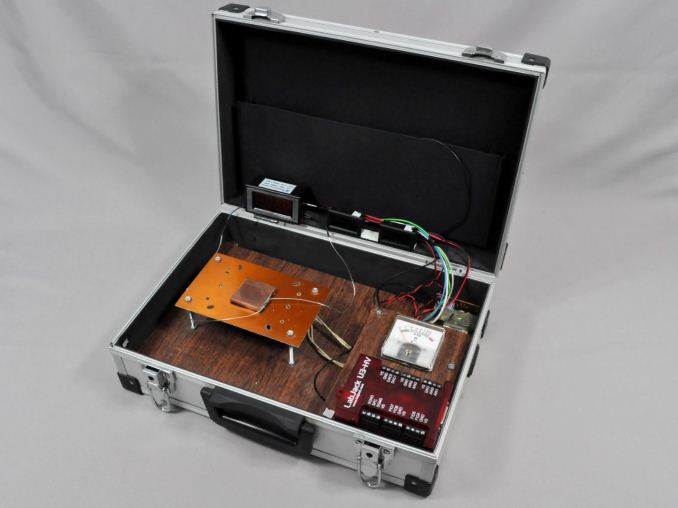
Appropriate thermal testing requires the creation of a proper testing station and the use of laboratory-grade equipment. Therefore, we created a thermal testing platform with a fully controllable thermal energy source that may be used to test any kind of cooler, regardless of its design and or compatibility. The thermal cartridge inside the core of our testing station can have its power adjusted between 60 W and 340 W, in 2 W increments (and it never throttles). Furthermore, monitoring and logging of the testing process via software minimizes the possibility of human errors during testing. A multifunction data acquisition module (DAQ) is responsible for the automatic or the manual control of the testing equipment, the acquisition of the ambient and the in-core temperatures via PT100 sensors, the logging of the test results and the mathematical extraction of performance figures.
Finally, as noise measurements are a bit tricky, their measurement is being performed only manually. Fans can have significant variations in speed from their rated values, thus their actual speed during the thermal testing is being acquired via a laser tachometer. The fans (and pumps, when applicable) are being powered via an adjustable, fanless desktop DC power supply and noise measurements are being taken 1 meter away from the cooler, in a straight line ahead from its fan engine. At this point we should also note that the Decibel scale is logarithmic, which means that roughly every 3 dB(A) the sound pressure doubles. Therefore, the difference of sound pressure between 30 dB(A) and 60 dB(A) is not "twice as much" but nearly a thousand times greater. The table below should help you cross-reference our test results with real-life situations.
The noise floor of our recording equipment is 30.2-30.4 dB(A), which represents a medium-sized room without any active noise sources. All of our acoustic testing takes place during night hours, minimizing the possibility of external disruptions.
| <35dB(A) | Virtually inaudible |
| 35-38dB(A) | Very quiet (whisper-slight humming) |
| 38-40dB(A) | Quiet (relatively comfortable - humming) |
| 40-44dB(A) | Normal (humming noise, above comfortable for a large % of users) |
| 44-47dB(A)* | Loud* (strong aerodynamic noise) |
| 47-50dB(A) | Very loud (strong whining noise) |
| 50-54dB(A) | Extremely loud (painfully distracting for the vast majority of users) |
| >54dB(A) | Intolerable for home/office use, special applications only. |
*noise levels above this are not suggested for daily use
Testing Results, Maximum Fan Speed (12 Volts)
Most of the stock coolers were tested with a maximum load of 150W, lest we start a fire. These products were not meant to handle thermal loads way higher than the stock specifications of the CPUs they were being shipped with.
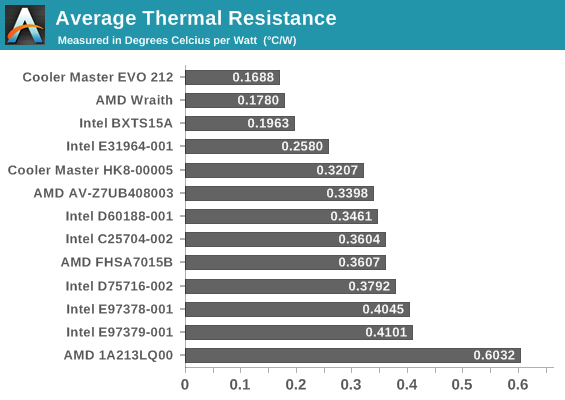
Looking immediately at the average thermal resistance and we see three main coolers out in front, and it is no surprise that these three are the beefiest - the EVO 212, the Wraith and the BXTS15A. The small Kabini cooler is designed for very low power, and our small test here pushes it outside of its window.
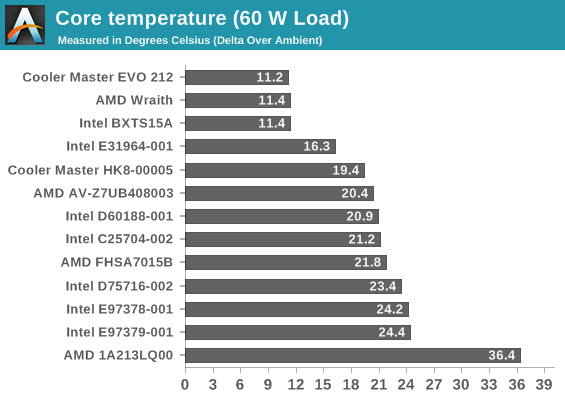
| Core Temperature, Constant Thermal Load (Max Fan Speed) |
As we move up the thermal loads, from 60W all the way up, the coolers by and large stay in their positions, with small differences becoming more pronounced as the load increases.
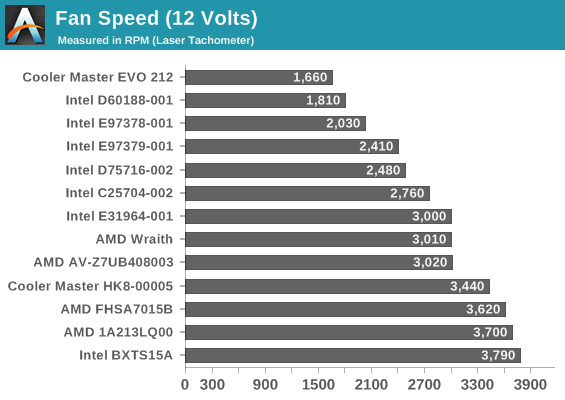
The EVO's large 120mm fan keeps the RPM down here, and it is interesting to see the RPM and noise of the BXTS15-A go far and above the other coolers.
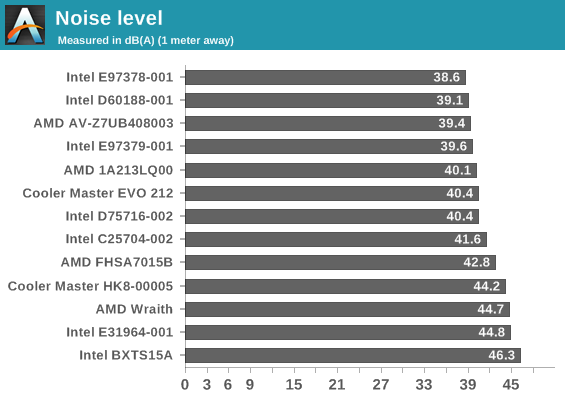
An interesting observation would be that Intel’s coolers meant for a specific socket have about the same absolute thermal resistance regardless of the core’s material. Taking socket 775 coolers as an example, the aluminum D75716-002 performs similarly with the copper C25704-002, most likely due to its solid core, and the tall copper D60188-001 also performs similarly due to the much slower (and quieter) fan. The same goes for the aluminum E97379-001 and the copper E97378-001 socket 1155 coolers, the former of which simply has a significantly more powerful fan attached. The E31964-001 performs significantly better but its high performance is not just due to its size and copper fins, as the fan is quite fast and loud as well.
In AMD’s camp, the simple and cheap FHSA7015B displays reasonable thermal performance at the expense of comfort, as the maximum speed of its fan is quite high. The more advanced AV-Z7UB408003 offers only slightly better thermal performance but noise levels were significantly lower. The Cooler Master HK8-00005 beats both of the aforementioned coolers in terms of thermal performance but its noise levels are rather high. This was to be expected, as it is based on the core design of the AV-Z7UB408003 but is significantly smaller, therefore a more powerful fan would have to make up for the loss of mass. Finally, the small 1A213LQ00 realistically has by far the worst overall performance of every cooler we tested here today, as the little cooler is designed with AMD’s power efficient AM1 CPUs in mind and cannot be directly compared to any of the other coolers in this review.
Both of AMD’s Wraith and Intel’s aftermarket BXTS15A stand out, pulling ahead in terms of performance the rest of the stock coolers. AMD’s Wraith is but a breath away from Cooler Master’s EVO 212 and the BXTS15A does not fall far behind. There is a catch though and that is the fans. Both the Wraith and the BXTS15A are making use of very strong fans, with a much higher top speed than that of the 120 mm fan that the EVO 212 is using. Strong fans are not just inherently louder themselves but the high air turbulence they create effectively multiplies the sound pressure level of the setup.
Testing Results, Low Fan Speed (7 Volts)
Intel’s E97379-001 and AMD’s AV-Z7UB408003 coolers are equipped with automatic speed correction circuitry and adjust their speed to the maximum regardless of the input voltage. This renders the majority of basic fan controllers, rheostats and simple fan speed reduction resistors useless. Their speed can only be controlled via a PWM signal from a motherboard. The E97379-001 did have a small speed drop with an input of 6.5V and we included those results, but the AV-Z7UB408003 was rather adamant and devoid of a PWM signal would always automatically correct its speed to 3000 RPM, giving us the exact same performance results as before.
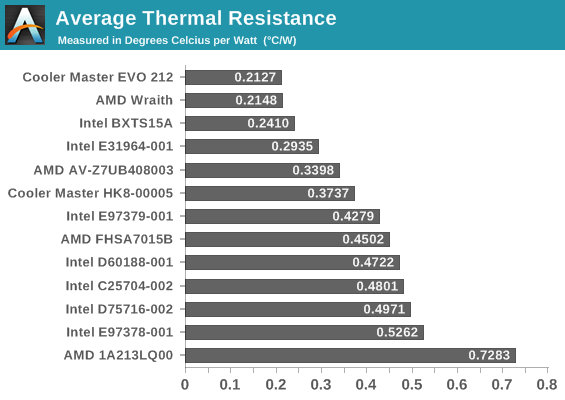
Again, the three most powerful coolers take the top spots at reduced power.
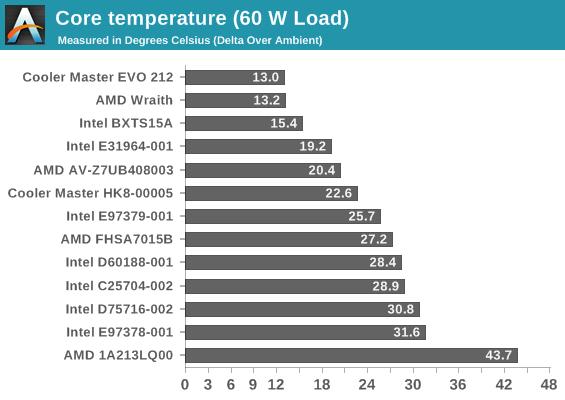
| Core Temperature, Constant Thermal Load (Low Fan Speed) |
Similarly to the 12V results, the EVO, Wraith and BXTS15A are taking the top spots. It's useful to note that EVO 212 and the Wraith are essentially equal as the power increases, with the Wraith being marginally ahead at very high thermal loads.
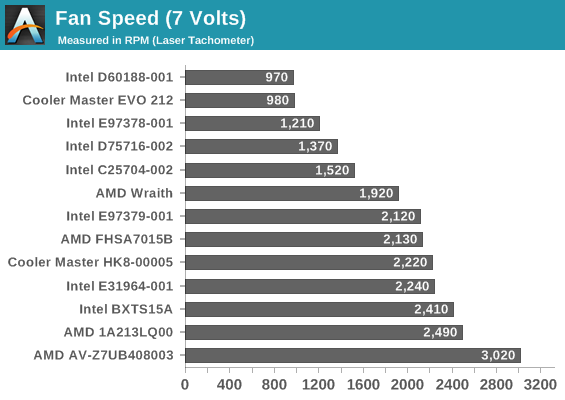
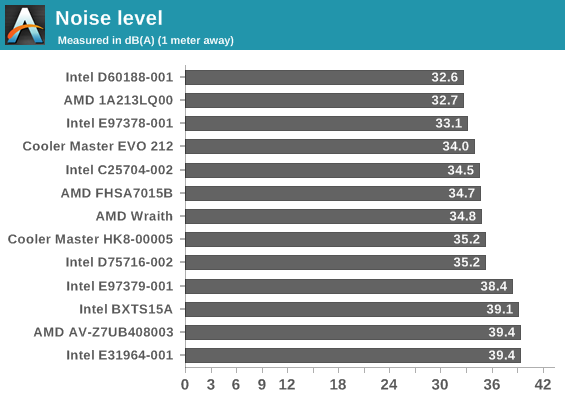
Putting the two "abnormal" coolers with non-adjustable fan settings aside, the thermal performance of the other coolers decreased almost equally, leaving their standings untouched. The D75716-002 still performs similarly to the C25704-002 and the D60188-001, but the former still is the loudest and the latter still is the quietest of the three. As a matter of fact, the D75716-002 is louder than the C25704-002, even though the fan is slower, hinting that either the fan has a worse engine or the denser fins significantly increased the airflow resistance of the cooler.
We cannot compare the AV-Z7UB408003 cooler to the rest of AMD’s coolers due to the autocorrecting fan. Nevertheless, we can make a useful observation looking at the Cooler Master’s HK8-00005 performance. Despite it has a slightly lower mass compared to that of the FHSA7015B and virtually the same fan, its thermal performance is much better, showcasing how two simple heatpipes can significantly increase the efficiency of a cooler.
Once again, AMD’s Wraith goes directly head to head with Cooler Master’s EVO 212, only this time the Wraith also compares in terms of acoustic comfort. There is virtually no difference between the two coolers in terms of thermal performance and both are equally silent with their fan input voltage reduced down to 7 Volts. The Intel BXTS15A does compare in terms of thermal performance but falls significantly behind when it comes to acoustics, as the cooler remains clearly audible even with its fan’s speed reduced by nearly 40%.
Final Words
In this review we have put together a dozen stock coolers from AMD and Intel, going back through several years, and compared them against a popular off-the-shelf aftermarket cooler. Both AMD and Intel supply stock coolers with most of their processors as a form of 'guaranteed' to work with the processor, but not all solutions are equal, and do not take into account absolute performance or noise. Because AMD has recently launched their high-end Wraith and near-silent stock coolers with their performance processors, we actively went to source a number of these as well as the Cooler Master EVO 212 for an overall comparison.
| Vendor | Cooler | Common Bundle | Core | Fins | Fan (mm) |
Mass (g) |
| Intel | D75716-002 | Socket 775 Celerons | Alu | Alu | ≈80 | 118 |
| C25704-002 | Socket 775, P4 6x0 | Cu | Alu | ≈80 | 132 | |
| E97378-001 | Socket 1155 Intel i5 | Cu | Alu | ≈80 | 146 | |
| E97379-001 | Socket 1155 Intel i3 | Alu | Alu | ≈80 | 92 | |
| D60188-001 | Socket 775, C2D E8x00 | Cu | Alu | ≈80 | 419 | |
| E31964-001 | Socket 1366 i7-X | Cu | Cu/Alu | ≈100 | 435 | |
| BXTS15A | Aftermarket, ≈$30 | Cu | Alu | ≈80 | 362 | |
| AMD | 1A213LQ00 | AMD “Kabini” AM1 | Alu | Alu | 50 | 75 |
| FHSA7015B | Several AMD Lines | Alu | Alu | 70 | 164 | |
| AV-Z7UB408003 | Black Edition Phenom | Alu +2 Cu HP |
Alu | 70 | 374 | |
| Wraith (125W) | AMD FX-8370 AMD A10-7890K |
Cu +4 Cu HP |
Alu | 90 | 304 | |
| Cooler Master | HK8-00005 | AMD FM2+ “Godavari” | Alu | Alu | 70 | 125 |
| EVO 212 | Aftermarket, ≈$30 | Cu +4 Cu HP |
Alu | 120 | 436 |
Intel’s line of stock CPU coolers seem to have been designed to have characteristics agnostic to the requirements of the specific socket it was bundled with. The main difference between the coolers ends up being the noise that the cooler generates. For example, both of the 1155 coolers had similar absolute thermal resistance, but the copper core E97378 is significantly quieter. As one might expect, the only cooler that was an exception to that rule was the one bundled with a $1000 CPU (E31964-001). However, that does not mean that the coolers of cheaper CPUs will perform worse or necessarily be louder overall.
Cheap low power CPUs also have lower thermal losses than the high end models based on similar technology, meaning that an 'inferior' heatsink will also likely have a lower thermal load to deal with. The main difference will be discernable only when the cooler is idling, as the copper core coolers can lower the speed of their fans to nearly inaudible levels. This is arguably the best takeaway message for stock coolers: copper cores help with noise rather than absolute thermal resistance.
For AMD's coolers, there is a clear dichotomy in their cooling range. The high-end parts, particularly those at 95W and above (and the A10-7860K), get the newest and best coolers.
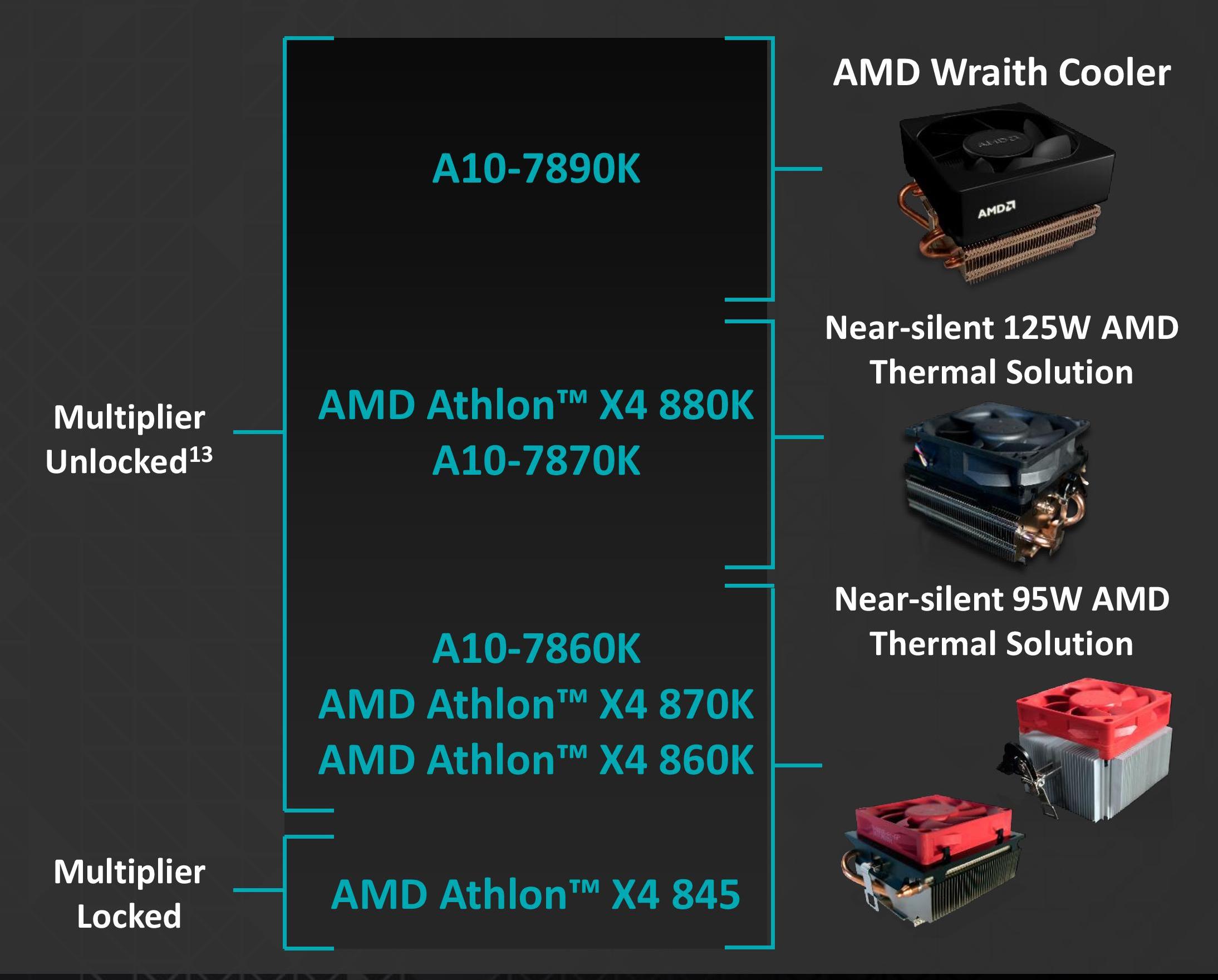
AMD's Cooler Lineup, with FX-8370 and FX-8350 also in the Wraith section
Most of their other CPUs come with the FHSA7015B, a cooler with mediocre overall performance that just gets the job done. Certain top tier models, such as the Godavari core FM2+ CPUs, come with advanced models that do offer higher overall performance and lower noise levels. The performance of these coolers may not be on par with mainstream tower coolers comparable to the Cooler Master EVO 212, but it is an upgrade comparable to buying an entry-level $15-20 tower aftermarket cooler and meeting the EVO half-way, in a sense. Only the latest 125W Wraith cooler is an exception, greatly outpacing even the Cooler Master HK8-00005 and AMD AV-Z7UB408003, coolers that were or are being supplied with other top tier CPUs.
Conclusion: AMD's Wraith is a Great Free $30 Upgrade
It's clear from the market that AMD is taking a broader interest in coolers recently, whereas Intel has taken a different direction with the new Skylake-K CPUs being sold without stock coolers. It creates an interesting platform where a good cooler might add to the cost of a processor, whereas the high performing CPUs remove their stock coolers to become more price competitive (even if you have to spend another $30 to get a cooler anyway).
But naturally, our conclusion is going to be dominated by the top performers of this roundup - the Intel BXTS15A, the AMD Wraith and the Cooler Master EVO 212.
AMD is supplying the Wraith for free alongside their top tier CPUs and it proved itself capable of performance comparable to that of a reputable mainstream cooler such as the Cooler Master EVO 212. The Wraith’s high thermal performance can be attributed to the strong 90 mm fan and heatpiped design. This saves the average user from spending a significant monetary sum for a good, silent cooler, as the Wraith is more than enough for everyday use and even for reasonable overclocking. For those that are interested, the AMD side lights up when powered as well.
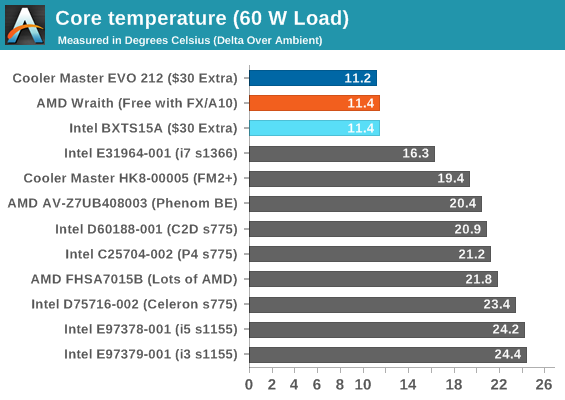
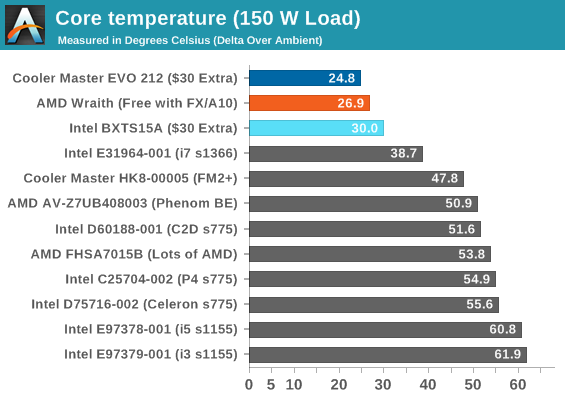
Intel supplies the BXTS15A as an aftermarket cooler, an upgrade over the stock coolers supplied alongside their CPUs. However, it hardly makes sense as an upgrade. There are several better aftermarket CPU coolers better than the BXTS15A with the same price tag, including the Cooler Master EVO 212 that was showcased in this review.
Most of Intel's CPU coolers are rated as 'good enough' for the platforms they target. However, there is no guarantee of long-term stability (note, dust) and we can see that audible performance when pushing a CPU can be excessive. If the BXTS15A was being supplied alongside a CPU then it could prevent some users from upgrading to better coolers, or it could be a viable option if it was selling for less than $20, but has little to no market value as a standalone product at such a retail price. If there are no space constraints or other mechanical issues (mounting security/strength, portability, etc.), then the recommendation is that a user bypasses the BXTS15A and moves straight on to something like the Cooler Master EVO 212 or other comparable aftermarket cooler.
A side note about noise:
It is rather ironic that both AMD and Intel are marketing their best coolers as “quiet” models, as they were among the loudest that we have tested here today when their fans were forced to operate at absolute maximum speed. AMD has stated that the Wraith 'shroud' over the top of the cooler is a few db louder (due to vibrations) than the near-silent variant, but affords additional lighting to show off the system. The catch with both the AMD and Intel solutions is that both of these coolers will actually be quiet when they replace the louder stock coolers that CPUs usually ship with, especially the smaller heatsinks of the cheaper models, although the Intel variant is an extra outlay. If the Wraith or the BXTS15A are installed on a stock CPU, their mass is enough to keep the CPU cool without relying much on airflow, allowing the thermal control of the motherboard to keep the fan’s speed (and noise) very low. It comes down to the cost of such a difference.
Cooling performance can change quickly if the CPU is constantly under heavy stress and/or overclocked, as the thermal losses of the CPU multiply under such conditions. Both companies obviously wanted to ensure that their top end coolers can hold the processors cool enough even under such conditions and thus they are using very strong fans that can provide high levels of airflow if needed. Ultimately the best way to increase airflow in these situations is with larger fans that run slower (such as the EVO), but this can be difficult when staying within specifications or having to design basic coolers to a price point without taking a loss.

